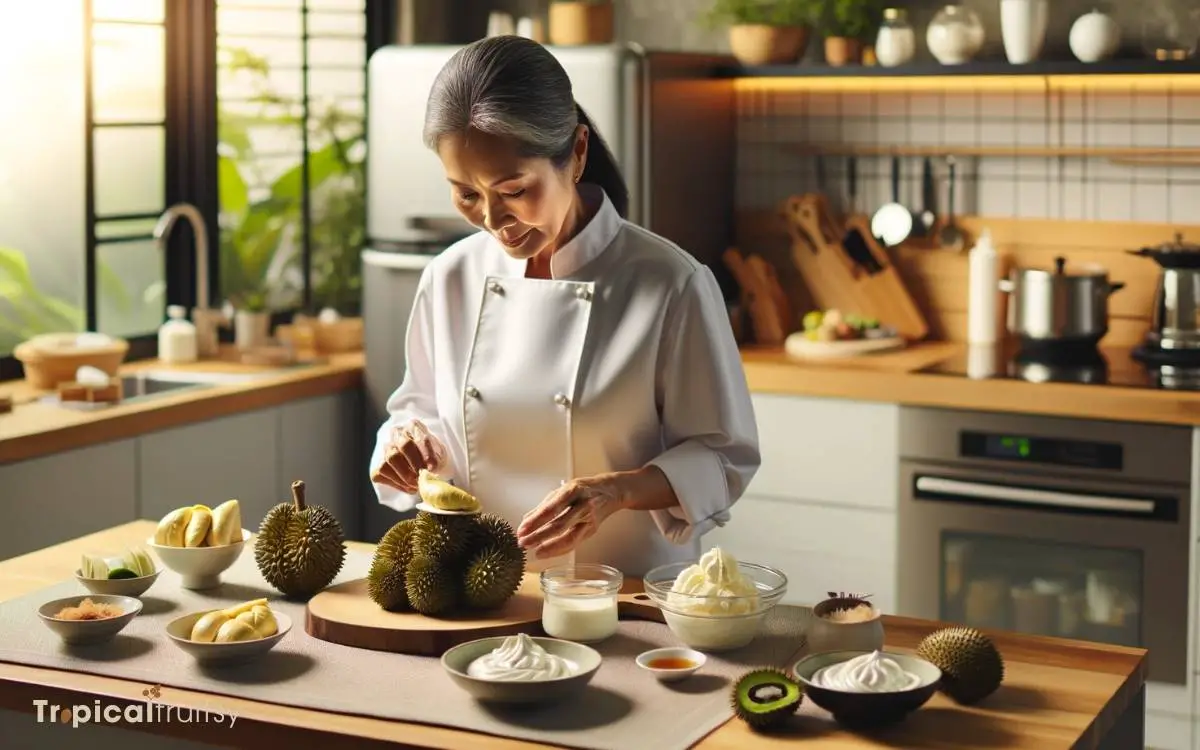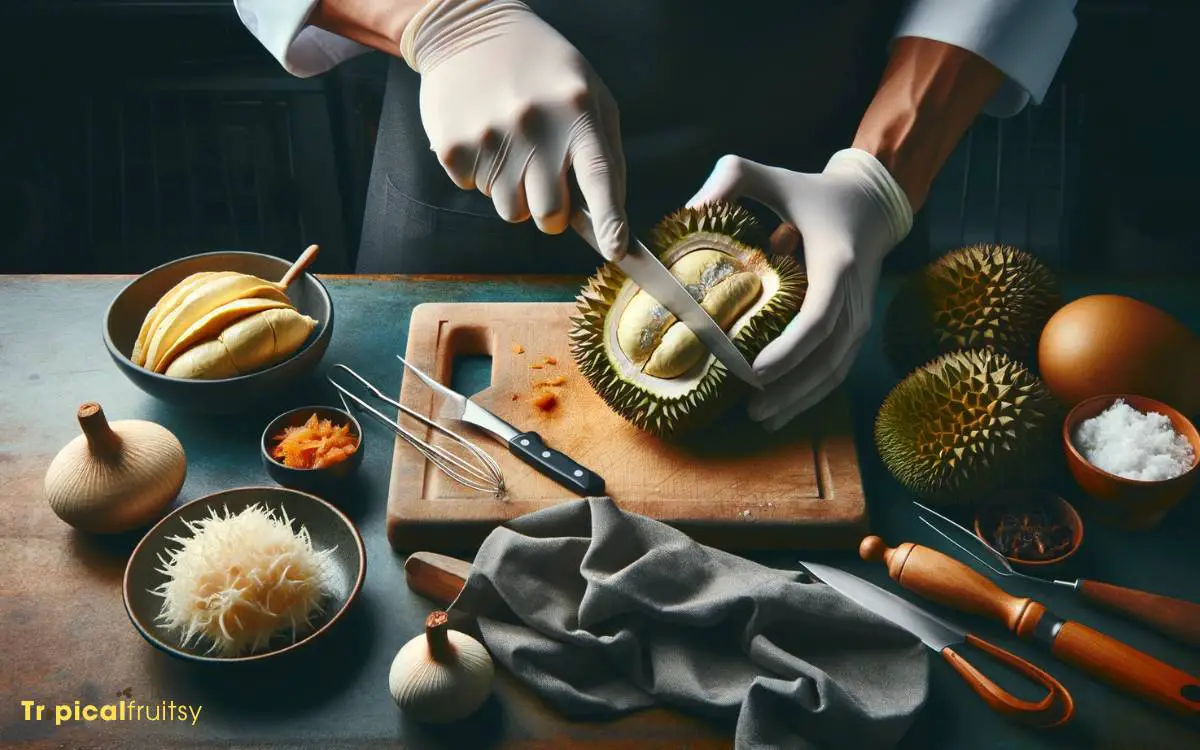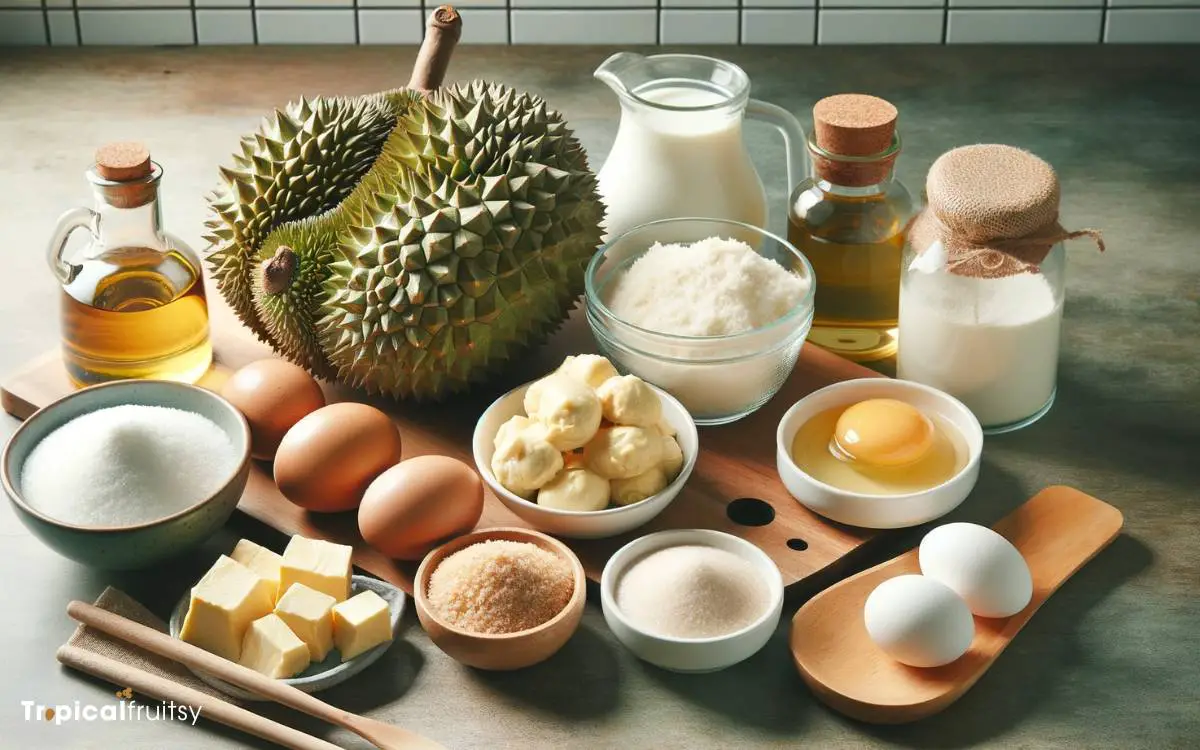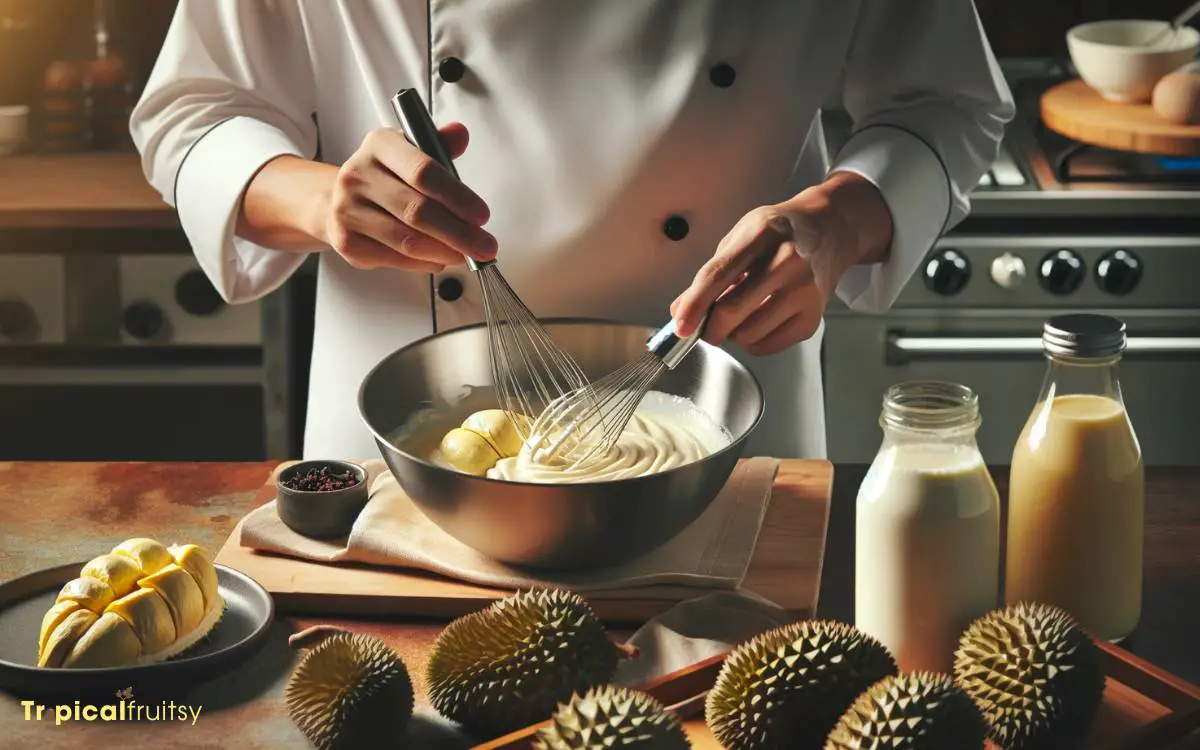How to Make Durian Dessert? 6 Easy Steps!
Creating a delectable durian dessert is a culinary adventure that can lead to a rewarding result.
Here’s a step-by-step guide on how to make durian dessert:
The final product can be transformed into a variety of desserts from ice cream to cakes, giving diners a unique taste experience.
To make a durian dessert, follow these steps:
- Choose a ripe durian: The fruit should be firm but give slightly to the touch.
- Prepare the durian: Wear gloves to protect your hands from the spiky husk, and cut the fruit open.
- Remove the seeds: Take out the large seeds and collect the creamy flesh.
- Mix with other ingredients: Combine the durian pulp with sugar, cream, or other elements depending on the recipe.
- Finalize the dessert: Whether it’s a custard or a pastry, incorporate the durian pulp appropriately.
- Serve and preserve: Present the dessert in an appealing way and store any leftovers properly.
For example, a simple durian mousse might include durian flesh, whipped cream, and gelatin.
Indulge in the king of fruits by mastering the art of durian dessert preparation, an exotic treat for the senses.

Key Takeaway
Step 1: Selecting the Perfect Durian

Choosing the right durian is essential, as every piece of fruit varies in flavor and ripeness. The selection process is both an art and a science, underpinned by subtle nuances that can greatly influence the outcome of your dessert.
Initially, assess the external appearance; a durian with a firm, intact stem and a body free of significant blemishes suggests maturity and gentle handling. A faint, sweet aroma indicates a degree of ripeness without being overpowering.
On handling, the durian should yield slightly under pressure, signifying a soft, custard-like flesh inside.
Furthermore, the sound of the durian can be telling; a subtle shake may reveal the presence of seeds moving within, suggesting the right level of ripeness for a delectable dessert base.
Step 2: Preparing Your Durian

Upon acquiring your durian, the initial step involves carefully opening the husk to access the creamy pulp within.
This process is critical and requires precision to ensure the flesh is not damaged, which could impact the texture and presentation of your dessert.
Use a sharp knife and make a cut along the seams of the durian, prying it open with a slight twist. Once opened, you will find the golden lobes of fruit encased in compartments—these are the edible parts you will use.
To guide you in this process, here is a succinct table outlining the necessary steps:
| Step | Tool | Description |
|---|---|---|
| 1 | Knife | Slice along the durian’s natural seams |
| 2 | Gloves | Protect hands from the sharp husk |
| 3 | Bowl | Collect the durian pulp |
| 4 | Spoon | Remove the seeds from the pulp |
| 5 | Airtight Container | Store unused portions properly |
Handle the pulp with care to maintain its delectable integrity for your dessert creation.
Step 3: Essential Durian Dessert Ingredients

The foundation of any durian dessert hinges on the excellence of its durian pulp. The pulp must exhibit a rich, creamy texture and a potent aroma characteristic of high-quality fruit.
To balance the robust flavor profile of the durian, a judicious selection of sweeteners is crucial. This can range from granulated sugar to honey or even coconut sugar, depending on the desired flavor complexity.
These core ingredients, coupled with precision in their proportions, are instrumental in crafting an authentic and satisfying durian dessert experience.
Durian Pulp Quality
Selecting high-quality durian pulp is crucial for the success of any durian dessert, as its flavor and texture are paramount to the dish’s overall appeal.
The ideal pulp should exhibit a rich, custardy consistency with a vibrant golden hue, signaling ripeness and optimal sugar content.
Connoisseurs prefer durian varieties that strike a balance between sweetness and a subtle bitter undertone, contributing to a complex taste profile.
When assessing pulp quality, one should also consider the aroma, which ought to be intensely fragrant, a hallmark of freshness. The absence of fibrous or overly mushy sections ensures a uniform culinary experience.
As the foundation of your dessert’s flavor matrix, this pulp will interplay with other ingredients, notably sweeteners.
Identifying the right pairing enhances the durian’s natural sweetness, thereby segueing us into the art of complementary sweeteners selection.
Complementary Sweeteners Selection
Every durian dessert benefits from the careful incorporation of sweeteners that complement its distinctive taste without overpowering the nuanced flavors of the premium pulp.
The selection of sweeteners is a critical step in achieving a harmonious balance in taste. Natural sweeteners such as honey, raw cane sugar, or coconut sugar possess complementary profiles that enhance the fruit’s complexity.
These sweeteners introduce a depth of flavor while maintaining the integrity of the durian’s unique taste.
In contrast, refined sugars, though effective sweeteners, may lack the same dimensional quality and could potentially mask the durian’s intricate notes. Artisans often opt for less processed options to ensure the dessert’s authenticity and richness.
With the right sweetener enhancing the durian’s flavor profile, the next pivotal step involves crafting durian cream that is sumptuously smooth and perfectly married with the chosen sweetener.
Step 4: Crafting Durian Cream

Moving forward, the creation of durian cream is pivotal in achieving the quintessential texture and flavor of our dessert.
Selecting a durian at the peak of ripeness is crucial, as it imparts the characteristic richness essential to the cream’s base.
Selecting Ripe Durian
Regarding the selection of ripe durian for your dessert, it is crucial to identify fruit with a firm stem, a strong sweet aroma, and a slight give when gently squeezed, as these characteristics are indicative of peak ripeness essential for crafting a sumptuous durian cream.
The flesh should be vibrantly golden and yield a creamy consistency, without any signs of fibrousness or over-fermentation, which can manifest as an overpowering alcoholic scent.
As you assess the fruit, look for a uniform, bulbous shape, which often suggests a well-distributed internal structure, conducive to a balanced flavor profile.
The exterior husk should exhibit a natural sheen rather than dullness, a subtle indication of the fruit’s vitality.
Mastery in identifying these nuances empowers the confectioner to elevate the sensory appeal of the final dessert.
Cream Texture Tips
To achieve the quintessential durian cream texture, meticulous attention must be given to the blending process, ensuring a smooth and velvety consistency that complements the natural richness of the selected ripe durian.
Mastering this element is not merely a step but an art in the creation of a captivating durian dessert.
Here are three key recommendations:
- Chill the Durian Pulp: Prior to blending, refrigerate the durian pulp. Cold temperatures firm the fruit, reducing separation and improving the final cream’s body.
- Balance with a Stabilizer: Incorporate a small quantity of stabilizer, such as cornstarch or cream of tartar, to maintain a luxurious texture that holds its shape.
- Gentle Folding: After blending, fold the durian puree into whipped cream gently to preserve airiness, avoiding over-mixing which can lead to a dense texture.
Sweetness Balance Techniques
While the texture of the durian cream is crucial, equally important is the delicate art of balancing the inherent sweetness of the fruit to cater to a wider palate range.
To achieve this culinary equilibrium, one must engage in precision alchemy, combining the robust, custardy flavor of durian with complementary ingredients that enhance and tame its sugary profile.
The process begins with the careful selection of durian flesh, ideally one that offers a complex bouquet of sweetness and bitterness.
This is then married with a calculated measure of heavy cream, which introduces a silky counterpoint to the fruit’s intensity.
A whisper of acid, perhaps from a squeeze of citrus, can cut through the sweetness, while a pinch of salt can elevate the flavors, ensuring the final durian cream sings harmoniously on the taste buds.
Step 5: Innovating Traditional Recipes

Several traditional durian dessert recipes can be creatively adapted to cater to contemporary tastes and dietary preferences.
By incorporating modern culinary techniques and alternative ingredients, chefs and food enthusiasts can reinvent these classic dishes.
This approach not only preserves the essence of the traditional flavors but also aligns with current health trends and diverse palates.
Here are some innovative adaptations:
- Vegan-Friendly Variations: Utilize plant-based creams and sweeteners to create dairy-free durian cakes and mousses.
- Low-Sugar Options: Experiment with natural sweeteners like stevia or monk fruit to reduce the sugar content without compromising taste.
- Deconstructed Presentations: Serve durian in novel ways, such as durian tiramisu or layered parfaits, to provide an interactive dining experience.
These innovations invite a broader audience to appreciate durian desserts while respecting culinary heritage.
Step 6: Serving and Preservation Tips

Upon completion of your durian dessert, proper serving and preservation are crucial to maintaining its freshness and flavor profile.
For optimal taste, serve the dessert chilled, allowing the cold temperature to subtly mellow the durian’s potent aroma while enhancing its creamy texture.
Use airtight containers to store any uneaten portions to prevent odor transfer to other foods within the refrigerator.
If freezing, ensure the dessert is tightly wrapped or sealed, which can extend its life for up to three months without significant loss of quality. Thawing should be gradual, ideally in the refrigerator, to maintain consistency.
To revive the flavors of a refrigerated dessert, consider a brief period at room temperature before serving. Always check for any signs of spoilage, such as discoloration or off odors, prior to consumption.
Conclusion
The culinary exploration of durian desserts offers a fascinating foray into the versatility of this unique fruit.
With a growing global interest, statistical data reveals that durian-based confections have seen a 15% increase in market share within the Southeast Asian dessert sector over the past five years.
This trend underscores the fruit’s potential in the confectionery industry and reflects an expanding palate among consumers for exotic and innovative dessert options.






